Genomic expression program of Saccharomyces cerevisiae along a mixed-culture wine fermentation with Hanseniaspora guilliermondii
- PMID: 26314747
- PMCID: PMC4552253
- DOI: 10.1186/s12934-015-0318-1
Genomic expression program of Saccharomyces cerevisiae along a mixed-culture wine fermentation with Hanseniaspora guilliermondii
Abstract
Background: The introduction of yeast starter cultures consisting in a blend of Saccharomyces cerevisiae and non-Saccharomyces yeast strains is emerging for production of wines with improved complexity of flavor. The rational use of this approach is, however, dependent on knowing the impact that co-inoculation has in the physiology of S. cerevisiae. In this work the transcriptome of S. cerevisiae was monitored throughout a wine fermentation, carried out in single culture or in a consortium with Hanseniaspora guilliermondii, this being the first time that this relevant yeast-yeast interaction is examined at a genomic scale.
Results: Co-inoculation with H. guilliermondii reduced the overall genome-wide transcriptional response of S. cerevisiae throughout the fermentation, which was attributable to a lower fermentative activity of S. cerevisiae while in the mixed-fermentation. Approximately 350 genes S. cerevisiae genes were found to be differently expressed (FDR < 0.05) in response to the presence of H. guilliermondii in the fermentation medium. Genes involved in biosynthesis of vitamins were enriched among those up-regulated in the mixed-culture fermentation, while genes related with the uptake and biosynthesis of amino acids were enriched among those more expressed in the single-culture. The differences in the aromatic profiles of wines obtained in the single and in the mixed-fermentations correlated with the differential expression of S. cerevisiae genes encoding enzymes required for formation of aroma compounds.
Conclusions: By integrating results obtained in the transcriptomic analysis performed with physiological data our study provided, for the first time, an integrated view into the adaptive responses of S. cerevisiae to the challenging environment of mixed culture fermentation. The availability of nutrients, in particular, of nitrogen and vitamins, stands out as a factor that may determine population dynamics, fermentative activity and by-product formation.
Figures

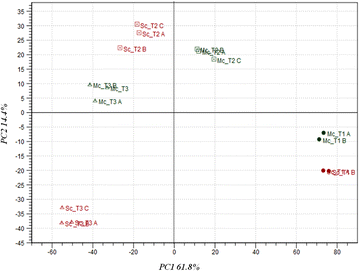
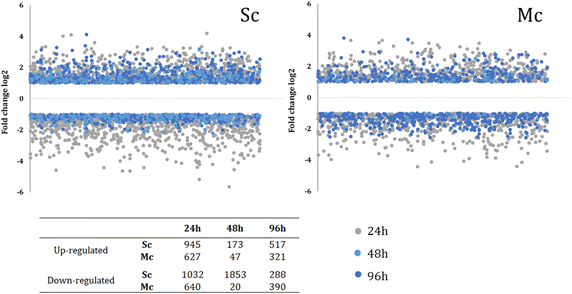
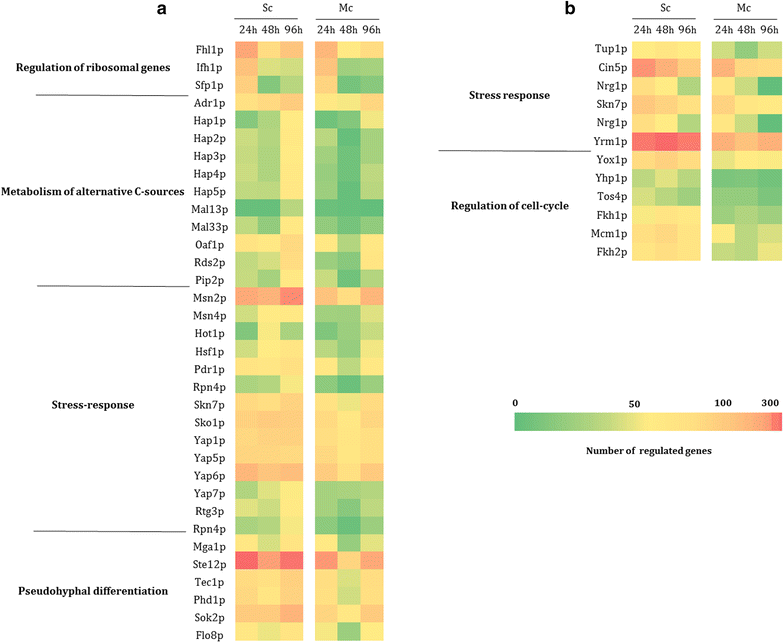
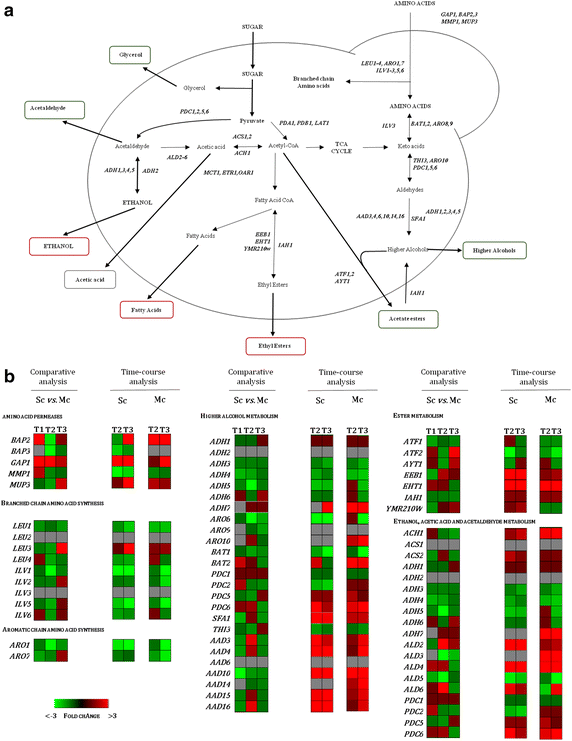

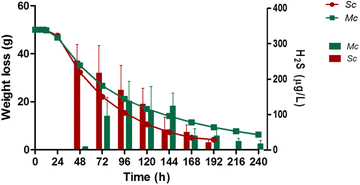
Similar articles
-
H. guilliermondii impacts growth kinetics and metabolic activity of S. cerevisiae: the role of initial nitrogen concentration.Int J Food Microbiol. 2014 Feb 17;172:62-9. doi: 10.1016/j.ijfoodmicro.2013.11.031. Epub 2013 Dec 7. Int J Food Microbiol. 2014. PMID: 24361834
-
Sequential inoculum of Hanseniaspora guilliermondii and Saccharomyces cerevisiae for winemaking Campanino on an industrial scale.World J Microbiol Biotechnol. 2018 Oct 24;34(11):161. doi: 10.1007/s11274-018-2540-6. World J Microbiol Biotechnol. 2018. PMID: 30357477
-
Genomic and Transcriptomic Basis of Hanseniaspora vineae's Impact on Flavor Diversity and Wine Quality.Appl Environ Microbiol. 2018 Dec 13;85(1):e01959-18. doi: 10.1128/AEM.01959-18. Print 2019 Jan 1. Appl Environ Microbiol. 2018. PMID: 30366992 Free PMC article.
-
Controlled mixed culture fermentation: a new perspective on the use of non-Saccharomyces yeasts in winemaking.FEMS Yeast Res. 2010 Mar;10(2):123-33. doi: 10.1111/j.1567-1364.2009.00579.x. Epub 2009 Sep 7. FEMS Yeast Res. 2010. PMID: 19807789 Review.
-
The Important Contribution of Non-Saccharomyces Yeasts to the Aroma Complexity of Wine: A Review.Foods. 2020 Dec 23;10(1):13. doi: 10.3390/foods10010013. Foods. 2020. PMID: 33374550 Free PMC article. Review.
Cited by
-
Non-conventional Yeast Species for Lowering Ethanol Content of Wines.Front Microbiol. 2016 May 4;7:642. doi: 10.3389/fmicb.2016.00642. eCollection 2016. Front Microbiol. 2016. PMID: 27199967 Free PMC article. Review.
-
Comparing the Effects of Different Unsaturated Fatty Acids on Fermentation Performance of Saccharomyces cerevisiae and Aroma Compounds during Red Wine Fermentation.Molecules. 2019 Feb 1;24(3):538. doi: 10.3390/molecules24030538. Molecules. 2019. PMID: 30717212 Free PMC article.
-
Secondary Aroma: Influence of Wine Microorganisms in Their Aroma Profile.Foods. 2020 Dec 27;10(1):51. doi: 10.3390/foods10010051. Foods. 2020. PMID: 33375439 Free PMC article. Review.
-
Transcriptomics Provides a Genetic Signature of Vineyard Site and Offers Insight into Vintage-Independent Inoculated Fermentation Outcomes.mSystems. 2021 Apr 13;6(2):e00033-21. doi: 10.1128/mSystems.00033-21. mSystems. 2021. PMID: 33850038 Free PMC article.
-
Genome sequence of the non-conventional wine yeast Hanseniaspora guilliermondii UTAD222 unveils relevant traits of this species and of the Hanseniaspora genus in the context of wine fermentation.DNA Res. 2019 Feb 1;26(1):67-83. doi: 10.1093/dnares/dsy039. DNA Res. 2019. PMID: 30462193 Free PMC article.
References
-
- Jolly N, Augustyn O, Pretorius IS. The role and use of non-Saccharomyces yeasts in wine production. S Afr J Enol Vitic. 2006;27:15–39.
-
- Mora J, Barbas JI, Mulet A. Growth of yeast species during the fermentation of musts inoculated with Kluyveromyces thermotolerans and Saccharomycescerevisiae. Am J Enol Vitic. 1990;39:156–159.
-
- Soden A, Francis IL, Oakey H, Henschke PA. Effects of co-fermentation with Candida stellata and S. cerevisiae on the aroma and composition of Chardonnay wine. Aust J Grape Wine Res. 2000;6:21–30. doi: 10.1111/j.1755-0238.2000.tb00158.x. - DOI
Publication types
MeSH terms
LinkOut - more resources
Full Text Sources
Other Literature Sources
Molecular Biology Databases

